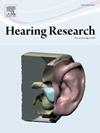Neural tracking of continuous speech in adverse acoustic conditions among healthy adults with normal hearing and hearing loss: A systematic review
IF 2.5
2区 医学
Q1 AUDIOLOGY & SPEECH-LANGUAGE PATHOLOGY
引用次数: 0
Abstract
The study of neural speech tracking (NST) has gained increasing attention in the field of auditory neuroscience in recent years. However, its contribution to speech perception in noise (SPiN), especially regarding aging and hearing loss, has yet to be fully explored. This systematic review examined NST in adults with and without hearing loss, focusing on its modulation by age, hearing impairment, and adverse acoustic conditions, as well as its relationship with behavioral SPiN performance. A systematic literature search identified studies using electroencephalography (EEG) or magnetoencephalography (MEG) to investigate NST in continuous speech processing under adverse acoustic conditions. Studies included participants with and without hearing loss, excluding those with neurological disorders. Various NST methods, including forward and backward modeling, coherence, and cross-correlation, were examined. Fifty-four studies met the inclusion criteria. Most studies focused on young adults, with fewer studies including older adults or individuals with hearing loss. Findings suggest that older adults exhibit increased NST compared to younger adults, potentially reflecting compensatory mechanisms for auditory processing declines. Similarly, hearing impairment was generally associated with enhanced NST, likely due to altered neural encoding and increased reliance on cognitive resources. The impact of adverse acoustic conditions, as reflected by the signal-to-noise ratio (SNR), on NST was predominantly negative, with NST decreasing as noise levels increased. However, some studies suggested a non-linear relationship, with NST peaking at intermediate SNRs. Furthermore, most studies reported a positive correlation between NST and SPiN performance, typically observed across individuals or conditions within homogeneous groups or pooled samples. While stronger tracking was generally associated with better behavioral outcomes, this relationship does not imply that higher NST always corresponds to better performance across different populations. Age and hearing loss appear to modulate NST, likely through both neural compensation and auditory processing adaptations. The complex effects of SNR on NST highlight the need for additional research to better understand its underlying mechanisms. Future studies should delve deeper into the interplay between aging, cognition, and auditory deficits in shaping NST, offering a more comprehensive understanding of speech processing in challenging acoustic environments.
听力正常和听力损失的健康成人在不利声学条件下连续言语的神经跟踪:一项系统综述
神经语音跟踪(NST)的研究近年来在听觉神经科学领域受到越来越多的关注。然而,其对噪声中语音感知(SPiN)的贡献,特别是对衰老和听力损失的影响,尚未得到充分的探讨。本系统综述研究了有听力损失和无听力损失的成年人的NST,重点关注其受年龄、听力障碍和不利声学条件的调节,以及其与行为SPiN表现的关系。系统的文献检索确定了使用脑电图(EEG)或脑磁图(MEG)研究在不利声学条件下连续语音处理中的NST的研究。研究包括有听力损失和没有听力损失的参与者,不包括那些有神经系统疾病的参与者。研究了各种NST方法,包括正向和向后建模、相干性和相互关系。54项研究符合纳入标准。大多数研究集中在年轻人身上,很少有研究包括老年人或听力损失患者。研究结果表明,与年轻人相比,老年人表现出更高的NST,这可能反映了听觉处理下降的补偿机制。同样,听力障碍通常与NST增强有关,可能是由于神经编码改变和对认知资源的依赖增加。正如信噪比(SNR)所反映的那样,不利的声学条件对NST的影响主要是负的,NST随着噪声水平的增加而降低。然而,一些研究表明,NST与中等信噪比的峰值存在非线性关系。此外,大多数研究报告了NST和SPiN性能之间的正相关关系,通常在同质组或合并样本中的个体或条件中观察到。虽然更强的跟踪通常与更好的行为结果相关,但这种关系并不意味着在不同的人群中,更高的NST总是对应着更好的表现。年龄和听力损失似乎通过神经补偿和听觉处理适应来调节NST。信噪比对NST的复杂影响突出了进一步研究以更好地了解其潜在机制的必要性。未来的研究应该更深入地研究衰老、认知和听觉缺陷在形成NST中的相互作用,从而对具有挑战性的声学环境中的语音处理提供更全面的理解。
本文章由计算机程序翻译,如有差异,请以英文原文为准。
求助全文
约1分钟内获得全文
求助全文
来源期刊

Hearing Research
医学-耳鼻喉科学
CiteScore
5.30
自引率
14.30%
发文量
163
审稿时长
75 days
期刊介绍:
The aim of the journal is to provide a forum for papers concerned with basic peripheral and central auditory mechanisms. Emphasis is on experimental and clinical studies, but theoretical and methodological papers will also be considered. The journal publishes original research papers, review and mini- review articles, rapid communications, method/protocol and perspective articles.
Papers submitted should deal with auditory anatomy, physiology, psychophysics, imaging, modeling and behavioural studies in animals and humans, as well as hearing aids and cochlear implants. Papers dealing with the vestibular system are also considered for publication. Papers on comparative aspects of hearing and on effects of drugs and environmental contaminants on hearing function will also be considered. Clinical papers will be accepted when they contribute to the understanding of normal and pathological hearing functions.
 求助内容:
求助内容: 应助结果提醒方式:
应助结果提醒方式:


